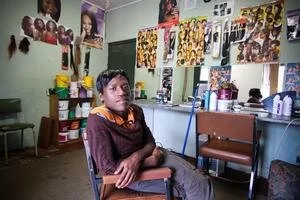So you’ve got a flair for hair-dressing, and you’ve got some training and experience? Great start, but now what?
Here are some ideas for going out on your own – without becoming one of those failed business statistics.
As you will know by now, there is no shortage of hairdressers in South Africa. It’s a tough market to break into, but you can do it if you are focused and careful about it.
Whatever you do, don’t rush into spending money on premises and equipment before you’ve thought hard and planned ahead.
Start by looking at yourself: are you the right kind of person for this work? Are you friendly and interested in people, while at the same time being professional with your service? Your customers are likely to be from various age groups and social backgrounds.
You must be able to communicate with all of them and adapt your approach to best suit their individual needs. Are you fit and healthy? You will need plenty of stamina to work long hours on your feet every day, while keeping a smile on your face.
Do you really, really love hair? You should be interested not just the latest hairstyles and hairdressing techniques, but also fashion trends generally – as this all goes together to improve your customer’s ‘look’.
You also should be a regular reader of magazines such as the South African Hairdressers Journal, Image and Hair and Beauty Africa.
Does your personal appearance show how interested you are in your field of work? You will always need to be well groomed, with a high standard of personal hygiene, as you will be ‘up close and personal’ with your customers!
YOUR CUSTOMERS
Now you need to think about your target market. More than 10 million South African adults visit a hair salon at least once a month, and two-thirds of these are women. About 75% of people going to a salon are black, so there is much more demand for afro salons. Try and focus on a certain niche market – a smaller segment of the total market – to whom you think you can offer something special. This will help you compete, and will affect where you set up premises, the prices you charge and the range of specialist services you offer.
Professional women are going to make up a large portion of your client base. These women earn their own money and can spend a substantial amount on personal care, clothes and cosmetics. They are also quite busy and so often do not have time to come in to a salon for a couple of hours to have their hair done.
You could offer after-hours appointments for these women or offer services such as express cut and blow-drying treatments during their lunch hours.
There is a demand for hairdressers qualified in braiding, relaxing and straightening. You may want to open a salon that specialises in this market only or may include it in the services that you offer.
These days, men are taking more of an interest in body image and grooming. Many barbers have taken notice of this trend and are offering a variety of male grooming services such as shaving and manicures.
If you run a unisex salon, you will be able to reach the profitable market of young professional males as well as your traditional female base.
Children and teenagers will also be other potential customer groups for you. Most young girls and teenagers are aware of their personal image and want to keep up to date with the latest styles and trends.
You may want to offer special rates or packages for this younger market since it may encourage parents to bring children to you instead of a salon that charges the same rate as adults.
Brides, their mothers and their bridesmaids all need to have their hair styled on the wedding day, so you could offer early morning appointments and special rates to these bridal parties.
Some hairdressers offer additional services such as Indian head massages and beauty therapies such as manicures.
Your clients can have these treatments done while they wait.
- Paul Crankshaw is from Cobweb Information. For more information on starting a business in various industries, go to www.cobwedinfo.co.za.
Getting trained and qualified
You need to do theoretical and practical training before you can become a qualified hairdresser. Courses include the National Certificate in Hairdressing NQF Level 2, the National Certificate in Hairdressing NQF Level 3, and the Further Education and Training Certificate in Hairdressing NQF Level 4.
Once you have completed a qualification, you need to do practical training as an apprentice, under the supervision of a qualified hairdresser. After that, you can do a Theory Board Examination and a compulsory trade test set by the Department of Labour.
No person under the age of 21 can be employed in a salon without having applied for a learnership or apprenticeship.
A useful website to visit is www.sahair.co.za for more information on workshops and training programmes.


